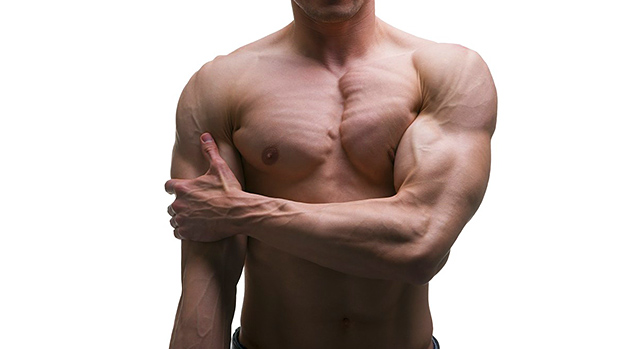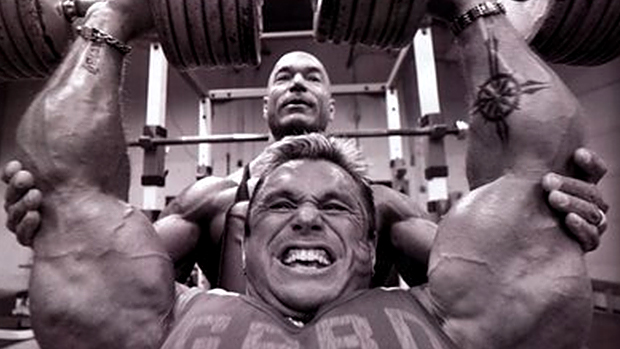Recover Fast, Grow Fast!
Want to gain muscle mass, strength, or power in the fastest way possible? Making rapid progress is a function of two interrelated variables: training stress and restoration/recovery. Basically, you can increase your rate of progress either by improving your training, or improving your body's capacity to recover from training.
If you've been reading T-Nation for some time, you probably already know a thing or two about how to enhance the efficacy of your training. However, the ways of improving post-training restoration might be somewhat nebulous to you. That's sad really, because proper restorative measures can make a huge difference in how fast you attain your objectives.
Simply put, proper use of restorative measures will:
- Enhance the amount of progress made between each session
- Reduce the risk of injuries
- Help to deal with minor aches and pains
- Allow you to train more intensely, more often, with more regularity
In this article I'll discuss a few restorative methods I use that have stood the test of time. You don't have to apply all of them at the same time though. In fact, Soviet literature demonstrates that a periodized restorative approach is better than an holistic approach.
First, let's take a look at the top seven various restorative techniques:
- Epsom salts baths
- Restorative pulse electromyostimulation
- Cryotherapy
- Contrast baths/showers
- Glycogen/protein resynthesis drinks
- Neural restorative drinks
- Massage
Epsom salt is also known as magnesium sulphate. Our first restorative technique consists of bathing for 10 to 20 minutes in a warm/hot bath to which 200-400 grams of Epsom salt is added. This is a very simple and effective way to relax your muscles and decrease inflammation. It's also a good way to increase blood magnesium levels and prevent bloating due to excessive water retention.
A recent study conducted at the University of Birmingham found that bathing in a warm Epsom salt bath can significantly increase mean blood magnesium levels (the average improvement consisting of attaining 140,98 ppm/ml from an initial value of 104.68ppm/ml in a seven days period). This is because magnesium can be absorbed by the skin. We know that magnesium is a very important mineral for athletes, and one that we're often deficient in. Among other things, it helps with muscle relaxation and Testosterone production.
Epsom salt baths increase perspiration, helping to get rid of toxins and impurities. Magnesium sulphate also stimulates vasodilatation, facilitating blood flow to the muscles and helping reduce inflammation. As a result, these baths can greatly increase the rate of recovery after a hard training session and, as a bonus, they reduce muscle and joint pains associated with an excessive inflammatory response.
The Birmingham study found that up to 600 grams of Epsom salt diluted in a normal size bath can be used effectively and without risk. However, they found that levels of 300 to 400 grams are sufficient. This technique should be used two to three times per week for 10 to 20 minutes after particularly gruelling workouts.
Sub-tetanic (non-maximal) EMS utilized in a low-intensity pulsating manner can act much like a sports massage. It can stimulate blood flow to the muscles by creating a pumping effect. It can also induce a state of relaxation in the muscles and help breakdown adhesions between muscle fibers.
A discharge frequency of 1 to 9Hz is recommended for this purpose and the duration of the treatment should be 15 to 20 minutes. Intensity (current amperage) should be kept low. Yet another benefit of this type of EMS is an analgesic effect or a diminution of pain. This is best accomplished at a frequency of 5Hz.
One recovery method I find to be particularly effective is to drink a protein and carbohydrate shake and have an EMS recovery session 15 minutes after. This will bring a lot of amino acids and glucose to the muscle, speeding up its reconstruction and supercompensation.
I personally use a Compex sport unit, which has several pre-planned programs (power, strength, resistance, endurance, active recovery and potentiation).
This technique refers to ice massage. Put some baby oil on your muscle (to prevent shock) and put ice in the middle of your muscle belly. Start to gently massage the muscle in a circular motion with the ice. Gradually increase the diameter of the circles. Perform this action for five to ten minutes. This strategy is very effective at decreasing pain and excessive inflammation and can thus help prevent overuse injuries.

Ice massages can also be used in conjunction with heat therapy (either a hot bag, hot shower/bath or sauna). Use the ice massage first, then the heat therapy. This will drastically increase blood flow to the muscles. Ice massage will constrict blood flow and the subsequent heat therapy will facilitate blood flow, creating a sort of pumping effect.
Don't use this ice/heat technique if you're injured as it could increase inflammation. For pain relief and reduction of overuse injuries and inflammation, stick to ice massages only.
Alternate between 30 seconds of cold water and two minutes of hot water. Perform this cycle three or four times. This technique is very effective at increasing peripheral blood flow, thus facilitating recovery. Again, don't use this method if you're suffering from an overuse injury or excessive inflammation.
Note that the warmth of the hot water segment will vary in its effect. You should be careful to select the proper temperature for your objective. For example, very hot water (104-113 Fahrenheit or 40-45 degrees Celsius) lowers muscle tension and decreases neuralgia. Warm water (95-99 Fahrenheit or 35-38 degrees Celsius) will mostly have a general relaxing effect.
According to Kurz (2001), the type of baths/showers you use should vary according to your activity. Use a warm or hot bath after a strength and speed-strength session. Use a cool bath after an endurance workout.
In the case of contrast showers and relative to strength training, I'll make the following recommendations:
- After a high intensity workout (strength or speed-strength work), alternate between 30 seconds of cool water (but not too cold) and two minutes of hot water.
- After a high volume workout (hypertrophy or strength-endurance work), alternate between 30 seconds of cold (as cold as you can stand) and two minutes of warm water.
To quote our good Doctor Berardi:
"For rapid recovery from exercise, immediately after a workout (strength or endurance), we must:
- Rapidly replenish the low glycogen stores in our muscles.
- Rapidly decrease the muscle protein breakdown that occurs with exercise.
- Rapidly force further increases in muscle protein synthesis.
(From "Solving the Post-Workout Puzzle," Jan. 26th 2001)
Failure to accomplish any one of these objectives will lead to a lowered rate of recovery from your workout. And the slower the recovery process is, the less growth you can stimulate!
Studies have found that delaying nutrient (protein and carbohydrate) consumption after a workout can greatly reduce the rate of glycogen restoration and protein synthesis. In fact, the rate of glycogen synthesis is reduced by 50% if nutrients aren't consumed immediately after a workout (Maehlom et al. 1977, Blom et al. 1987, Ivy et al. 1988).
Furthermore, it's important to understand that post-workout protein synthesis increases (what will lead to increased muscle mass) are in part due to the rate of glycogen synthesis, increased insulin levels, and increased insulin sensitivity from the workout (Garetto et al. 1984, Richter et al. 1984, Cortee et al. 1989). As we just saw, delaying post-workout nutrients absorption will drastically decrease the rate of glycogen synthesis, which will negatively affect protein synthesis.
Plus, a few hours after a workout, the insulin sensitisation stimulated by the bout of training will be much lower: there's a two to threefold increase in insulin sensitivity immediately post-workout. After two or three hours, it's down to only 44% above baseline (Levenhagen et al. 2001). So basically, if you wait too long after your workout to consume a mix of fast absorbing proteins and high glycemic carbohydrates, the amount of muscle you'll build in response to your session will be significantly decreased.
Another interesting point is brought up by a study by Tipton et al. (2001) which has demonstrated that pre-workout supplementation with proteins and carbohydrates leads to a greater rate of protein synthesis following a workout than simply consuming the same drink immediately after the session.
An ideal post-workout formula would include fast-absorbing proteins, high glycemic carbs, and some additional BCAAs (which have been shown to drastically increase protein synthesis and decrease protein breakdown on their own).
The best restoration drink available is Surge® Workout Fuel. For best results, I suggest using half a serving immediately before your workout and one serving immediately after.
Emphasis on supplementation for increased neural efficiency has just begun to take its place in the sun. For a while it was something that only innovative coaches who were "in the know" utilized. Now it's really catching on.
At first, supplementing with nootropic supplements such as Brain Candy® was used to potentiate a workout: basically you'd drink it 30 minutes or so before a session to maximize performance. And it's very effective at that. However, I recently began using it after a workout. Why? Because I found that using it this way can actually increase CNS recovery!
As you might know, having a fresh CNS is one of the keys to optimal performance. Even if your muscles are fully rested and ready to roar, if "the boss" is half dead, nothing will happen. By combining a neural restorative drink with a muscular restoration drink, adaptation from each workout will be maximized and you'll grow like never before!
I suggest using one serving of Power Drive mixed in your post-workout Surge drink.
Contrary to what most people believe, massage therapy doesn't actually increase blood flow to the muscles (Shoemaker et al. 1997), so this isn't the mechanism of action for this particular restorative technique. However, massage still provides several benefits.
First of all, massages do increase lymph circulation and can reduce inflammation (especially deep tissue massage). In fact, Active Release Technique (ART), a form of deep tissue massage, is probably the most effective non-pharmaceutical treatment for inflammation injuries such as tendonitis. Massage can also increase the elasticity of the ligaments and muscles. It also has a general relaxing effect on the body.
Massage has a significant impact on the nervous system via an activation of reflexive mechanisms (Mierzejewski, 1988). Depending on the type of massage used, you can either lower excessive CNS excitation or increase it. Massage of the neck/trapezius area has a calming effect: slowing down heart rate and metabolism and increasing vasodilatation. Massaging the lower back area (especially using the stroking technique) will have the opposite effect (Kurz, 2001). In other words, massaging the neck area will put the body into restoration mode while massaging the lower back will put the body into action mode.
The duration of the massage treatment will vary depending on the size of the athlete and whether it's a localized or whole-body massage. Kurz, quoting Geselevich (1976), gives the following recommendations:
- Bodyweight of 132lbs or less: whole body = 40 minutes, localized = 20 minutes
- Bodyweight 133-165lbs: whole body = 50 minutes, localized = 25 minutes
- Bodyweight 166-220lbs: whole body = 60 minutes, localized = 30 minutes
- Bodyweight +220lbs: whole body = more than 60 minutes, localized = 35 minutes
Localized massage can be performed as a self-massage (except for the back muscles, unless you're Cirque du Soleil material), while whole body massage requires hiring a therapist. Whole body massage is best used once or twice per week. Most athletes shouldn't have more than two whole body massages per week, unless they're in an overtraining state.
Learning about the various restoration techniques is the easy part. The hard part comes when it's time to use the right methods at the right time. You see, your body will adapt to restorative methods just like it will to training methods. In other words, what works now might not work for long if you use it all the time.
I always say that a beginner should stay away from advanced training techniques. Why? Because the beginner doesn't need them: he'll progress on the most basic program if it's well constructed. Furthermore, since the body adapts to any training technique, using advanced methods too soon (when they aren't necessary) will render them much less effective in the future when they're truly needed to further progress.
Same thing goes for restorative methods. Don't use the most effective methods after low-stress workouts or low-stress blocks of training. Keep them in stock for when you really need them: during periods of revved-up training!
Without going into too much detail, here's a short list of guidelines that should help you make better use of the restorative techniques explained above:
Method to Use All the Time
The only method that should be used with every workout is the glycogen/protein resynthesis drink. Using such a drink represents the necessary first step toward starting the adaptation engine. Miss it and you'll see your gains drastically reduced. Since your body needs nutrients after each bout of training, you can't use this method sporadically; it must be used all the time if you're serious about making rapid progress.
Methods to Use After High Intensity Sessions
By "high intensity" I mean workouts using a high force output. Since force is equal to mass times acceleration, high intensity workouts will refer to sessions in which you either lift big weights (above 85% of your maximum on average) or lift explosively (Olympic lifts, speed bench/speed squat, plyometrics, ballistic lifts).
After that type of training, the best thing for you to do is use a neural restoration drink. Basically, add Power Drive to your post-workout meal.
If the session was particularly gruelling, use a contrast bath/shower alternating between cool (but not too cold) and hot water. If the session was hard, but nothing out of the ordinary, only take a warm to hot bath. A localized massage to the neck/trapezius area at least one hour after the workout will help reduce excitation.
Methods to Use After a High Volume Session
If the session was very hard and left you winded, go for a contrast shower alternating cold (as cold as you can stand) and warm water. If the session was arduous but nothing extraordinary, stick with only a cool shower/bath.
Methods to Use Weekly (1-2 Times a Week)
A whole-body massage, especially during periods of high training stress, would be ideal. An Epsom salt bath at the end of a gruelling training week is also perfect. Two consecutive days of Epsom salt baths will supercharge you for your next week of training.
Methods to Use When You Have Tendon Pain
Cryotherapy applied to the injured muscle can be performed for three to five days in a row, but after a training session involving the injured structure is the most important time.
Active recovery EMS would also be ideal here.
Stimulate, Recover, Repeat
This is merely an introduction to using natural means to speed up your recovery. A whole book could be written on the subject. However, if you properly use the simple methods presented above, your gains are sure to make a drastic move upward!
Remember that progress is dependent on the amount of stimulation placed on your body and on the capacity of your body to deal with and recover from that stimulation. By using restoration techniques, you're actually working on both factors: by recovering faster and more completely, you're able to train more often and more intensely and your body can overcome the training stress more easily.
It's a simple, effective, and cheap way to boost your gains!





